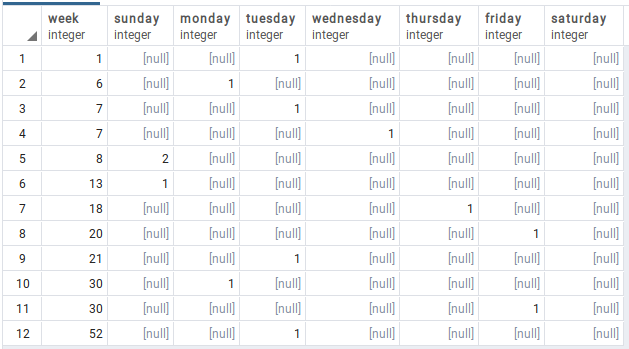I've worked on "Seven Databases in Seven Weeks" recently, and when implementing the the task with building a pivot table using crosstab() - the task was already described here: https://stackoverflow.com/questions/34665186/creating-a-calendar-like-table-using-crosstab-in-postgres?rq=1
I faced kind of PostgreSQL "magic" for ORDER BY clause.
The right query is:
SELECT * FROM crosstab (
'SELECT extract(week from starts) AS week,
extract(dow from starts) AS day, count(*)
FROM events
GROUP BY week, day
ORDER BY week',
'SELECT generate_series(0,6)'
) AS (
week int,
Sunday int, Monday int, Tuesday int,
Wednesday int, Thursday int, Friday int, Saturday int
) ORDER BY week;
The data in the table the following:
It will return this data:
If I were to omit the ORDER BY week in first query in crosstab() function, it's will return 12 rows instead of 10.
SELECT * FROM crosstab (
'SELECT extract(week from starts) AS week,
extract(dow from starts) AS day, count(*)
FROM events
GROUP BY week, day',
'SELECT generate_series(0,6)'
) AS (
week int,
Sunday int, Monday int, Tuesday int,
Wednesday int, Thursday int, Friday int, Saturday int
) ORDER BY week;
Output:
There are three strange things here:
- first is that when to run EXPLAIN VERBOSE on both of the queries, it show the completely identical QUERY PLAN except ORDER BY clause;
- when to run the sub-queries separately it will return 12 rows for both;
- ORDER BY clause should impact on the order only.
QUERY PLAN
--------------------------------------------------------------------------------------
Sort (cost=59.83..62.33 rows=1000 width=32)
Output: week, sunday, monday, tuesday, wednesday, thursday, friday, saturday
Sort Key: crosstab.week
-> Function Scan on public.crosstab (cost=0.00..10.00 rows=1000 width=32)
Output: week, sunday, monday, tuesday, wednesday, thursday, friday, saturday
Function Call: crosstab('SELECT extract(week from starts) AS week,
extract(dow from starts) AS day, count(*)
FROM events
GROUP BY week, day
ORDER BY week'::text, 'SELECT generate_series(0,6)'::text)
(10 rows)
QUERY PLAN
--------------------------------------------------------------------------------------
Sort (cost=59.83..62.33 rows=1000 width=32)
Output: week, sunday, monday, tuesday, wednesday, thursday, friday, saturday
Sort Key: crosstab.week
-> Function Scan on public.crosstab (cost=0.00..10.00 rows=1000 width=32)
Output: week, sunday, monday, tuesday, wednesday, thursday, friday, saturday
Function Call: crosstab('SELECT extract(week from starts) AS week,
extract(dow from starts) AS day, count(*)
FROM events
GROUP BY week, day'::text, 'SELECT generate_series(0,6)'::text)
(9 rows)
How to explain this behvaior? The closest question was this, but it's not the same I think: Why does changing the sort order return a different number of results? Is it a bug?
Thanks in advance.



